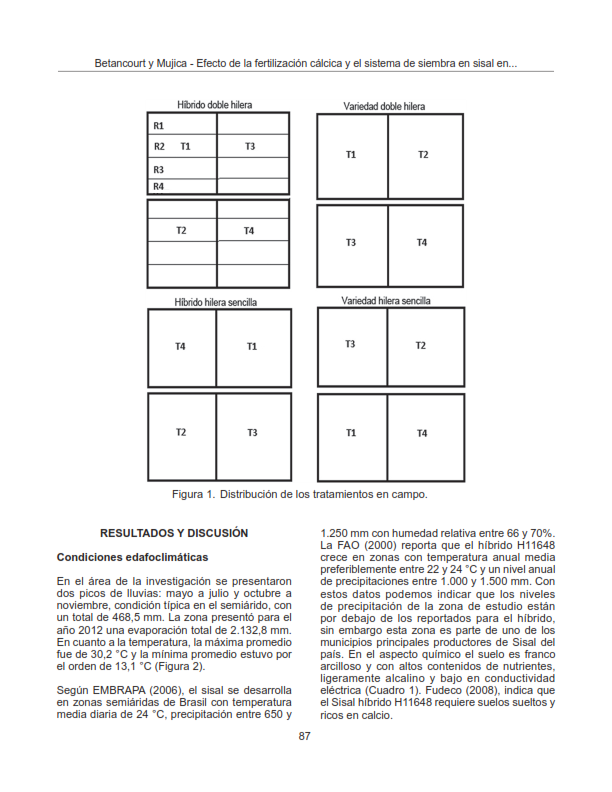Effect of the calcium fertilization and the cropping system of sisal crop in a sector of the semiarid of Lara State
Abstract
Sisal production offers an alternative under conditions of the semi-arid climate of Lara state. This research was conducted in order to evaluate the response of a variety of sisal (Agave sisalana) and hybrid H11648, to calcium fertilization and two planting systems. Eight plots of 9 x 12 m, four for the variety and four for the hybrid were established. Four doses of dolomitic lime (0, 150, 250 and 350 g / plant) were applied. Five plants of the three central rows per plot, every 30 days, were measurements of plant height, number, length, and width of leaves for 12 months. The design was a randomized block with four replications. Significant differences (P<0.05) were observed in the values of leaf width according to the type of sisal, a dose of lime applied and planting system. In addition, there was a significant difference (P<0.05) in the values of leaves per plant according to the type of sisal, but not in relation to the dose of lime applied and the planting system. For plant height and leaf length, a significant difference (P<0.05) between the types of agave, but not at the dose of lime and seeding system was observed. It is concluded that 250 to 350 g / plant is the most suitable lime dose.The variety of sisal, showed superiority over the hybrid 11648 regarding plant height with 99.6 cm, width and length of the blade with values of 13.66 13.66 and 85.4 cm, but is less production of leaves per plant.
Downloads
References
• EMBRAPA (Empresa Brasilera de Investigación Agropecuaria). 2006. Cultivo de sisal na regiao semiárida do Nordeste Brasileiro. Sistemas de Produção. 05. 42 p.
• FAO (Organización de las Naciones Unidas para la alimentación y la Agricultura). 2000. Producción y comercialización de sisal en China: Cuadro retrospectivo y perspectivas futuras. Esc. Consultas fibras. N° 5. Roma.
• Ferreira-Da Silva, O., O. Carvalho, J. Dos Santos e R. Vieira. 1999. Estudo comparativo de algunas caracteristicas da Agave sisalana Perrine e do hibrido 11648, na primeira colheita. Rev. Ol. Fibros. v.3. (2): 65-70.
• Fudeco (Fundación para el Desarrollo de la Región Centro Occidental de Venezuela). 2007. Sisal H.11648. Establecimiento y plantación. Plan de desarrollo endógeno de la zona sisalera. Fudeco (Fundación para el Desarrollo de la Región Centro Occidental de Venezuela). 2008. Programa de extensión rural para la zona sisalera del estado Lara. Barquisimeto. 34 p.
• Johnson, D. 2000. Métodos multivariados aplicados al análisis de datos. Internacional Thomson editores. México. 566 p.
• Kimaro, D., B. Msanya and Y. Takamura. 1994. Review of sisal production and research in Tanzania. African Study Monographs. 15(4):227-242.
• Martínez, A. y D. Martínez. 1996. Diseño de experimentos con fertilizantes. Publicación especial 5, Sociedad Mexicana de la ciencia del suelo. Colegio de postgraduados. México. 155 p.
• Santiago, D., N. Rodríguez y G. Mogollón. 2002. Potencial papelero de la fibra de sisal (Agave sisalana). Rev. Forest. Venez. 46 (2):19-27.
• Punnapayak, H., M. Kahirun and P. Thanonkeo. 1999. Cellulolytic fungi and bioconversion of fiber from Agave sisalana. Science Asia. 25:13 3-136.





